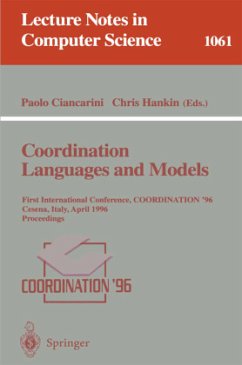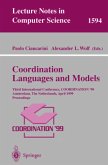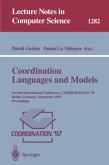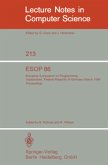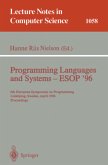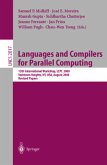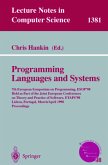CiancariniFirst International Conference, COORDINATION '96, Cesena, Italy, April 15-17, 1996. Proceedings.
Coordination Languages and Models
First International Conference, COORDINATION '96, Cesena, Italy, April 15-17, 1996. Proceedings.
Mitarbeit:Ciancarini, Paolo; Hankin, Chris
CiancariniFirst International Conference, COORDINATION '96, Cesena, Italy, April 15-17, 1996. Proceedings.
Coordination Languages and Models
First International Conference, COORDINATION '96, Cesena, Italy, April 15-17, 1996. Proceedings.
Mitarbeit:Ciancarini, Paolo; Hankin, Chris
- Broschiertes Buch
- Merkliste
- Auf die Merkliste
- Bewerten Bewerten
- Teilen
- Produkt teilen
- Produkterinnerung
- Produkterinnerung
This book constitutes the refereed proceedings of the First International Conference on Coordination Languages and Models, COORDINATION '96, held in Cesena, Italy in April 1996. Over the last few years, a new class of models, formalisms, and mechanisms for describing concurrent and distributed computations has emerged. A characteristic feature of these coordination languages and models is that they are based on (generative) communication via a shared data space. The 21 revised full papers presented were selected from a total of 78 submissions; also included are three invited papers and 10…mehr
Andere Kunden interessierten sich auch für
![Coordination Languages and Models Coordination Languages and Models]() Paolo Ciancarini / Alexander L. Wolf (eds.)Coordination Languages and Models39,99 €
Paolo Ciancarini / Alexander L. Wolf (eds.)Coordination Languages and Models39,99 €![Coordination Languages and Models Coordination Languages and Models]() Coordination Languages and Models39,99 €
Coordination Languages and Models39,99 €![ESOP 86 ESOP 86]() RobinetESOP 8639,99 €
RobinetESOP 8639,99 €![Programming Languages and Systems - ESOP '96 Programming Languages and Systems - ESOP '96]() NielsonProgramming Languages and Systems - ESOP '9639,99 €
NielsonProgramming Languages and Systems - ESOP '9639,99 €![Internet Programming Languages Internet Programming Languages]() Henri E. Bal / Boumediened Belkhouche / Luca Cardelli (eds.)Internet Programming Languages39,99 €
Henri E. Bal / Boumediened Belkhouche / Luca Cardelli (eds.)Internet Programming Languages39,99 €![Languages and Compilers for Parallel Computing Languages and Compilers for Parallel Computing]() Samuel P. Midkiff / Jose E. Moreira / Manish Gupta / Siddhartha Chatterjee / Jeanne Ferrante / Jan Prins / William Pugh / Chau-Wen Tseng (eds.)Languages and Compilers for Parallel Computing39,99 €
Samuel P. Midkiff / Jose E. Moreira / Manish Gupta / Siddhartha Chatterjee / Jeanne Ferrante / Jan Prins / William Pugh / Chau-Wen Tseng (eds.)Languages and Compilers for Parallel Computing39,99 €![Programming Languages and Systems Programming Languages and Systems]() HankinProgramming Languages and Systems39,99 €
HankinProgramming Languages and Systems39,99 €-
-
-
This book constitutes the refereed proceedings of the First International Conference on Coordination Languages and Models, COORDINATION '96, held in Cesena, Italy in April 1996. Over the last few years, a new class of models, formalisms, and mechanisms for describing concurrent and distributed computations has emerged. A characteristic feature of these coordination languages and models is that they are based on (generative) communication via a shared data space. The 21 revised full papers presented were selected from a total of 78 submissions; also included are three invited papers and 10 posters. All in all, these papers report the state of the art in this young and active area of research and development.
Produktdetails
- Produktdetails
- Lecture Notes in Computer Science 1061
- Verlag: Springer / Springer Berlin Heidelberg / Springer, Berlin
- Artikelnr. des Verlages: 978-3-540-61052-6
- 1996.
- Seitenzahl: 468
- Erscheinungstermin: 3. April 1996
- Englisch
- Abmessung: 235mm x 155mm x 26mm
- Gewicht: 624g
- ISBN-13: 9783540610526
- ISBN-10: 3540610529
- Artikelnr.: 09233326
- Herstellerkennzeichnung
- Springer-Verlag GmbH
- Tiergartenstr. 17
- 69121 Heidelberg
- ProductSafety@springernature.com
- Lecture Notes in Computer Science 1061
- Verlag: Springer / Springer Berlin Heidelberg / Springer, Berlin
- Artikelnr. des Verlages: 978-3-540-61052-6
- 1996.
- Seitenzahl: 468
- Erscheinungstermin: 3. April 1996
- Englisch
- Abmessung: 235mm x 155mm x 26mm
- Gewicht: 624g
- ISBN-13: 9783540610526
- ISBN-10: 3540610529
- Artikelnr.: 09233326
- Herstellerkennzeichnung
- Springer-Verlag GmbH
- Tiergartenstr. 17
- 69121 Heidelberg
- ProductSafety@springernature.com
Parallel multiset processing: From explicit coordination to chemical reaction.- Graph rewriting and constraint solving for modelling distributed systems with synchronization (extended abstract).- Coordination as constrained interaction (extended abstract).- The IWIM model for coordination of concurrent activities.- Sonia: An adaptation of Linda for coordination of activities in organizations.- The ToolBus coordination architecture.- Enhancing coordination and modularity mechanisms for a language with objects-as-multisets.- Towards a compositional method for coordinating Gamma programs.- Introducing a calculus for higher-order multiset programming.- ?2Log: Towards remote coordination.- A process algebra based on Linda.- Intra- and inter-object coordination with MESSENGERS.- Ariadne and HOPLa: Flexible coordination of collaborative processes.- Coordination in the ImpUnity framework.- Compiler correctness for concurrent languages.- A software environment for concurrent coordinated programming.- Designing a coordination model for open systems.- CCE: A process-calculus based formalism for specifying multi-object coordination.- An extensible framework for the development of coordinated applications.- Broadcasting in time.- Semantics of a higher-order coordination language.- Solving the Linda multiple rd problem.- Coordinating distributed objects with declarative interfaces.- Coordinating services in open distributed systems with Laura.- Visifold: A visual environment for a coordination language.- ALWAN: A skeleton programming language.- Weaving the Web using coordination.- Investigating strategies for cooperative planning of independent agents through prototype evaluation.- A case study of integration of a software process management system with software engineeringenvironments for process monitoring and management.- Nepi: A network programming language based on the ?-calculus.- Modelling interoperability by CHAM: A case study.- Integrating coordination features in PVM.- A simulator framework for embedded systems.- Understanding behavior of business process models.
Parallel multiset processing: From explicit coordination to chemical reaction.- Graph rewriting and constraint solving for modelling distributed systems with synchronization (extended abstract).- Coordination as constrained interaction (extended abstract).- The IWIM model for coordination of concurrent activities.- Sonia: An adaptation of Linda for coordination of activities in organizations.- The ToolBus coordination architecture.- Enhancing coordination and modularity mechanisms for a language with objects-as-multisets.- Towards a compositional method for coordinating Gamma programs.- Introducing a calculus for higher-order multiset programming.- ?2Log: Towards remote coordination.- A process algebra based on Linda.- Intra- and inter-object coordination with MESSENGERS.- Ariadne and HOPLa: Flexible coordination of collaborative processes.- Coordination in the ImpUnity framework.- Compiler correctness for concurrent languages.- A software environment for concurrent coordinated programming.- Designing a coordination model for open systems.- CCE: A process-calculus based formalism for specifying multi-object coordination.- An extensible framework for the development of coordinated applications.- Broadcasting in time.- Semantics of a higher-order coordination language.- Solving the Linda multiple rd problem.- Coordinating distributed objects with declarative interfaces.- Coordinating services in open distributed systems with Laura.- Visifold: A visual environment for a coordination language.- ALWAN: A skeleton programming language.- Weaving the Web using coordination.- Investigating strategies for cooperative planning of independent agents through prototype evaluation.- A case study of integration of a software process management system with software engineeringenvironments for process monitoring and management.- Nepi: A network programming language based on the ?-calculus.- Modelling interoperability by CHAM: A case study.- Integrating coordination features in PVM.- A simulator framework for embedded systems.- Understanding behavior of business process models.

